During the Christmas Season—nestled into the corner of the family room, in front of a grand bay window, or perched on a tabletop—Christmas trees can be found worldwide and are one of the most commonly thought of Christmas symbols. Each tree is uniquely decorated in every household and holds different traditions for each family. Colored or white lights? Tinsel or ribbon? Coordinated or a hodgepodge of different ornaments? Real or fake (some people have very strong feelings about this one)?
Christmas trees grace most Christmas songs in some form or another. We sing about the presents underneath and what we hope is tied up in pretty ribbons. We sing about dancing and fellowshipping around them. We sing about the soft glow that comes off of their lights at nighttime.
Some may even view the Christmas tree as a Christmas staple. Some may even say, "Can you really have a Christmas without one?" However, the often forgotten side of the Christmas tree is its history (from pagan uses to the entering of St. Boniface), the controversy surrounding it, and the deep meaning of the glowing evergreen in your home.
The Pagan History of the Christmas Tree
Prior to the establishment of Christianity, the cause of celebrations around the day we now recognize as Christmas was the observation of the Winter Solstice. The Winter Solstice is a reoccurring celestial event that marks the beginning of winter and is the shortest day of the year and, thus, the longest night of the year. As a result, many cultures would celebrate the day as a way to honor a god related to light.
In Egypt, the Winter Solstice brought with it a time to honor the God Ra as he began to recover from his illness. Ra was an Egyptian God who was believed to have a head of a hawk and used the sun as his crown. To honor Ra, Egyptians would display green palm rushes to symbolize the triumph of life over death.
In Scandinavia, the Vikings would use the Winter Solstice to display evergreens in their homes. In Viking culture, they viewed the tree as the special plant that honored their sun god, Balder.
In Early Rome, the Winter Solstice meant the celebration of the weeklong feast called Saturnalia, which honored the Roman agriculture god Saturn. Saturnalia marked when people knew that their agriculture would soon turn green again, so they decorated their homes and temples with evergreen boughs. However, the time also carried archaic traditions. During Saturnalia, there would be no consequences for those who participated in unlawful activities (i.e., rape, theft, murder). While not all individuals partook in such a tragic pastime, the time of Saturnalia was a time of kindness and even brought about gift-giving.
In the early days of Christianity, Roman officials, in an attempt to claim the time of year, announced the birth of Jesus Christ to be on December 25th. In doing so, Christmas overtook Saturnalia, but the use of evergreens would continue with St. Boniface.
St. Boniface and the Christmas Tree
St. Boniface was born in Devonshire, England, around A.D. 680. He knew he wanted to live a religious path from a young age. From age five, he wanted to be a monk, and he entered the abbey of Nursling in the Diocese of Winchester at age 7. After being a star pupil, he then became the director of the school.
In the late 7th century, central Europe had not yet been evangelized. Consequently, St. Boniface believed his purpose lay in being a missionary to central Europeans. Pope St. Gregory II, charged Boniface with preaching the Gospel in Germany. Boniface knew the biggest challenge he faced in his mission was the pagan-fueled superstitions of the area.
While traveling down a snowy, old Roman road on Christmas Eve, his followers begged to make camp, but Boniface insisted they push forward by saying:
“But we have work to do before we feast tonight. For this is the Yule-tide, and the heathen people of the forest have gathered at the Oak of Geismar to worship their god, Thor; and strange things will be seen there, and deeds which make the soul black. But we are sent to lighten their darkness; and we will teach our kinsmen to keep a Christmas with us such as the woodland has never known. Forward, then, in God’s name!”
Eventually, they happened upon a gathering. There was a huge bonfire and an evergreen at its center—the townspeople had gathered around. Leading the group was an old priest of Thor named Hunrad. St. Boniface and his group were welcomed into the festivities, and St. Boniface took his place next to Hunrad.
When Hunrad then selected a child named Asulf (the son of Duke Alvold and his wife, Thekla) to be sacrificed, St. Boniface remained quiet. Then Hunrad raised his sacred hammer of Thor and brought it down to little Asulf’s head. Boniface reached his crozier (e.g., pastoral staff), and when the hammer came in contact with it, the hammer shattered. With Asulf’s life saved—over the joyous cries of Thekla and sounds of awe from the crowd—Boniface began to preach the word of God. He then took an axe and cut down an evergreen.
The evergreen tree, now claimed by Boniface to be a symbol of celebration of life, was brought to the Duke’s house where it was decorated and people fellowshipped around it. Boniface then took this time to tell the story of Jesus and His birth to a captivated audience—including Hunrad.
Controversy Around the Christmas Tree
By the 17th century, Christmas trees had become more commonplace. However, they had created division as well.
Johann von Dannhauer, a Lutheran minister, insisted that they only served as a distraction from the true meaning of Christmas and the evergreen tree: Jesus Christ. Oliver Cromwell (the man who helped overthrow the Stuart monarchy in the English Civil Wars) believed Christmas trees (and even Christmas carols) were heathen practices. English Puritans also condemned Christmas trees and other Christmas season plants.
Christmas tree at Windsor Castle by Joseph Lionel Williams, Public domain, via Wikimedia Commons
The influence of the Johann von Dannhauer, Oliver Cromwell, and the English Puritans was actually pretty successful. Christmas trees became more of a rare Christmas tradition until Queen Victoria and Prince Albert popularised the Christmas tree in the mid-1800s.
A Christian Christmas Tree Wish
This Christmas, as you gather around your Christmas tree, may you hold close to your heart its true meaning: everlasting life from Jesus Christ. The evergreen is one of the few trees that never dies—though it does lose its leaves—a perfect reminder of your eternal life through God.
As you look upon the star or shining ornament on top of your Christmas tree, may you find comfort in knowing that Jesus is looking over you and of His unconditional, boundless love.
When you admire the ornaments, lights, and ribbons, may you find traces of all of God’s graces and reflect on all the many you received this year.
And finally, as you dig those presents out from under your Christmas tree, may you find a quiet moment to sit in gratefulness for all of God’s gifts and his most important one—the gift of his only begotten Son.
**Originally published December 21, 2022


